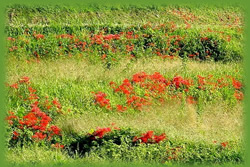 |
Higanbana,
‘equinox flower’ |
When
I break off the manjushage,
look—fire burns in my hands.
Haiku by Hashimoto Takako, 1899-1963CE
At the time of the equinox in Japan, clusters of red amaryllis appear, a harbinger of autumn. Higan—the ‘far bank’ or otherworld beyond the river separating this world from the next—is a Buddhist term for the seven days around the equinox, and this beautiful autumnal flower, known as Higanbana, is often found around the edges of rice paddies and graveyards. For 4 or 5 days the plant produces the vivid scarlet blooms; after it has flowered the colours rapidly fade, and the stalk collapses, the leaves appearing later in the season only to wither again in spring.* The flower is also known by the name manjushage from a line in the Buddhist Lotus Sutra: in Buddhist iconography, manjushage are one of the four varieties of heavenly flowers that inspire all those who see them to abandon evil.
Shunbun-no-hi or Higan No Chu-nichi is a Japanese national holiday that has its origin in both the seasonal observances of an agricultural people and Buddhist belief. At the time of the autumnal equinox, the heat of summer lessens, and the weather noticeably changes. During the summer O-Bon observance, the spirits of the dead are said to visit their descendants; on the seven days around the spring and autumn equinoxes, this process is reversed: special Buddhist ceremonies are performed and families visit the graves of their ancestors, to clean the tombs and leave gifts of flowers, incense and ohagi, rice balls covered with soybean paste.**
**The name comes from another autumnal flower, hagi, or bush clover; the same rice balls cooked for Shunbun-no-hi in spring are called botamochi, ‘peony cakes’.